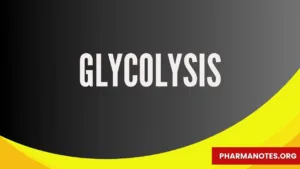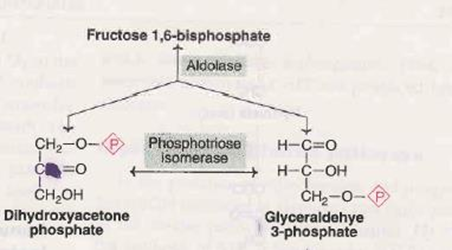Glycolysis

Objective
• At the end of this lecture, student will be able to
– Explain reaction involved in glycolysis
– Describe energetics of glycolysis
– Discuss the disorders associated with glycolysis
Glycolysis
• Universal pathway in the living cells
• Elucidated in 1940 by Embden-Meyerhof and referred to as Embden- Meyerhof pathway (E.M, pathway)
• Defined as the sequence of reactions converting glucose to pyruvate or lactate, with the production of ATP
• Chemical formula: C6H12O6
Salient features
• Takes place in all cells of the body & enzymes of this pathway are present in the cytosol of the cell
• Occurs in the absence of oxygen (anaerobic) or in the presence of oxygen (aerobic)
• Lactate is the end product under anaerobic condition & in aerobic condition pyruvate, which is then oxidized to CO2 & H2O
• Major pathway for ATP synthesis in tissues lacking mitochondria e.g. erythrocytes, cornea, lens etc.
• Very essential for brain which is dependent on glucose for energy
• Central metabolic pathway with many of its intermediates providing branch point to other pathways. Thus, the intermediates are useful for the synthesis of amino acids and fat
Reactions of glycolysis: The pathway can be divided into 3 phases
1. Energy investment phase or priming stage
2. Splitting phase
3. Energy generation phase.
1. Energy investment phase
• Glucose is phosphorylated to G-6-P by hexokinase or glucokinase
• This is an irreversible reaction, dependent on ATP and Mg2+
• G-6-P is impermeable to the cell membrane, thus, G-6-P undergoes isomerization to give F-6-P in the presence of phosphohexose isomerase and Mg2+
• F-6-P is phosphorylated to fructose 1, 6 bisphosphate by phosphofructokinase
• This is an irreversible and a regulatory step in glycolysis
2. Splitting phase
• 6 C fructose 1, 6-bisphosphates split to two 3C compounds glyceraldehyde-3-P & di hydroxyacetone phosphate by the aldolase
• Enzyme phosphotriose isomerase catalyses the reversible interconversion of glyceraldehyde-3-P & dihydroxyacetone phosphate. Thus, 2 molecules of glyceraldehyde- 3-phosphate are obtained from one molecule of glucose
3. Energy generation phase
• Glyceraldehyde-3-phosphate dehydrogenase converts glyceraldehyde-3- P to 1,3-bisphosphoglycerate
• This step is important as it is involved in the formation of NADH + H+ & high energy compound 1,3-bisphosphoglycerate
• NADH passes through the ETC & 6 ATP are synthesized by oxidative phosphorylation
• Enzyme phosphoglycerate kinase acts on 1,3-bisphosphoglycerate resulting in the synthesis of ATP and formation of 3-phosphoglycerate. This is a good example of substrate Ievel phosphorylation and reaction is reversible
• 3-Phosphoglycerate is converted to 2- phosphoglycerate by phosphoglycerate mutase. This is an isomerization reaction
• High energy compound phosphoenol pyruvate is generated from 2-phosphoglycerate by enolase, requires Mg2+ or Mn2+
• Enzyme pyruvate kinase catalyses the transfer of high energy phosphate from phosphoenol pyruvate to ADP, leads to form of ATP and pyruvate. This step also is a substrate level phosphorylation & reaction is irreversible
• Glycolysis under aerobic condition produce pyruvate and under anaerobic condition produce lactate
• Conversion of pyruvate to lactate is by lactate dehydrogenase and NADH
Lactic acidosis
• Normal plasma concentration lactic acid is 4-15 mg/dl
• Elevation of lactic acid in the circulation may occur due to its increased production or decreased utilization of lactic acid
• Mild forms are associated with strenuous exercise, shock, respiratory diseases, cancers/low pyruvate dehydrogenase activity
• Severe forms are observed due to impairment/collapse of circulatory system which is often encountered in MI, pulmonary embolism, uncontrolled hemorrhage and severe shock, which may even lead to death
Energetics: Production of ATP
• Under anaerobic conditions, 2 ATP are synthesized while, under aerobic conditions, 8 or 6 ATP are synthesized depending on the shuttle pathway that operates.
Irreversible steps in glycolysis
• Three steps catalyzed by enzymes hexokinase (or glucokinase), phosphofructokinase and pyruvate kinase, are irreversible steps
Regulation of glycolysis
• Three enzymes namely hexokinase phosphofructokinase and pyruvate kinase, catalysing the irreversible reactions regulate glycolysis
Summary
• Glycolysis also known as Embden-Meyerhof pathway
• Sequence of reactions converting glucose to pyruvate or lactate, with the production of ATP is known as glycolysis
• Glucose chemical formula is C6H12O6
• Glycolysis pathway is divided into 3 phases; Energy investment phase or priming stage, Splitting phase & Energy generation phase
• Elevation of lactic acid in the circulation is known as Lactic acidosis
• 8 ATP are synthesized in glycolysis
Also, Visit:
B. Pharma Notes | B. Pharma Notes | Study material Bachelor of Pharmacy pdf







